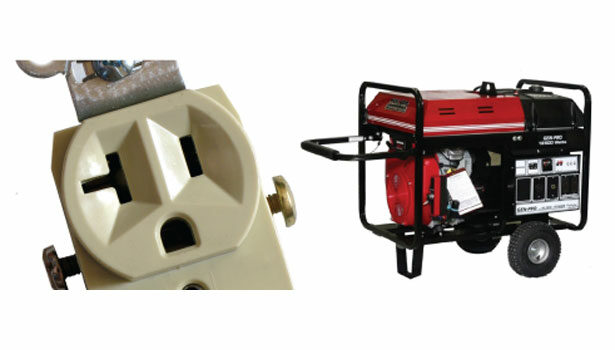Ensuring the best performance and productivity from your tools can be as simple as knowing where to plug in your equipment. The type and location of the power source, as well as the length of the electrical cords used and the thickness of the wire, can be crucial to not only tool performance but worker safety.
Since 90 percent of welding production problems result from power issues, let’s take a look at a few things you should keep in mind when connecting your equipment to a power source.
First of all, your generator should be on the roof with your tools — not on the ground — when plugging into a singular power source.
Line cords should be no longer than 100 feet in length. Using line cords more than 100 feet long will cause a drop in the voltage delivered to the tools. A drop in voltage will cause an increase in the amperage to your equipment, which can burn out elements, circuit boards and other electronic components.
The thickness of the wire used is also critical. The thinnest wire acceptable for 230-volt automatic overlap welders is 10 gauge. Any thinner gauge wire (noted by a higher number) will increase amperage to your equipment, causing damage to the tool and can possibly result in bodily harm to crew members. For handheld 120-volt tools, 12-gauge wire is the thinnest acceptable wire that can be used.
Based on our service experience, recommendations of membrane manufacturers and repair centers throughout the United States and Canada, the minimum wattage needed to simultaneously run hand welders and automatic overlap welders on the roof is 10,000 watts. That doesn’t mean you load up the outlet panels on the generator, as most generators will only carry a sustainable power load that is 10 percent lower than the total wattage available on that generator. Your 10,000-watt generator will only carry a load of 9,000 watts.
Be sure your generator will accommodate both 120-volt and 240-volt tools. There are separate outlets to support those tools, and each tool must be plugged into the proper outlet. While most 120-volt outlets operate on a standard 15-amp service, not all 120-volt tools operate on 15 amps. Others require a 20-amp outlet in order to perform, so check your tools and check the outlet. A 120-volt, 20-amp outlet has a slot that looks like a “T” turned sideways (see Figure 1). Remember, you can plug a 15-amp plug into a 20-amp outlet, but you cannot plug a 20-amp plug into a 15-amp outlet. Plugging a 20-amp tool into a 15-amp outlet will not only blow the ground fault circuit interrupter (GFCI) on the outlet, it could also damage your equipment as well as injure your crew. Play it safe, examine your plugs, and read the NEMA code on your plugs and your outlets.
To determine if your tool requires a 15-, 20- or 30-amp plug, simply divide the tool wattage by its voltage. For example, with a 1,600-watt, 120-volt standard hand welder, you would divide 1,600 by 120, resulting in 13.333amps. You would use a 15-amp plug and outlet.
Trying to save on using a generator by plugging into house power on the roof is a real gamble. Most 220 lines available on buildings only deliver 208 volts of power. Most 230-volt automatic overlap welders require 240 volts in order to run properly.
Make a volt meter part of your roofing toolbox. Plug each of the voltmeter leads into your hot lines (the straight line receptacles on your outlet). Each lead should register 120 volts, totaling 240 volts of power delivered. If you are only getting 104 volts on each lead, it’s not enough power.
As a commercial roofer using specially designed commercial tools, you should be using a generator built for commercial construction use on a tough eight-hour workday. While local big box stores sell a broad selection of generators at some spectacular prices, those generators are meant for the average homeowner’s use — not heavy commercial workloads for extended periods of time.
I suggest you buy your power source (generator and line cords) where you buy your commercial tools. All generators come with a user’s manual and warranty book. Please read this information and keep it on file in your office for any future service needs or user support.
While most folks feel the need to adjust the throttle on their generators, we recommend that you run your generator at full throttle for the benefit of the tool production. Keep you generator in a well-ventilated area and never cover it at lunchtime or at the end of the day until it has cooled down — otherwise you could risk a fire.
Also, keep your fuel tank full. Refill it after lunch or at the beginning of the day while the engine is cool. Generators running on low fuel will emit a higher-pitched motor hum. If you hear that, beware — your generator is desperately searching for fuel and can cause a power surge, which can severely damage your welder’s transformer and/or circuit boards. Keeping an eye on your gasoline tank could save you lots of time, aggravation and money.
Remember, power is always an issue on the roof, so be safe, be smart and be successful!





Report Abusive Comment